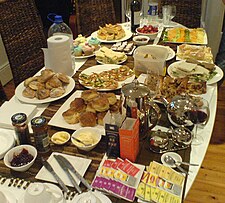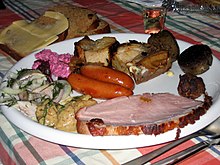Smorgasbord

Smörgåsbord (Swedish: [ˈsmœrɡɔsˌbuːɖ] ) is a type of Scandinavian meal served buffet-style with multiple dishes of various foods on a table, originating in Sweden.[1] In Norway it is called koldtbord, in Denmark it is called det kolde bord, in Finland seisova pöytä, in Iceland it is called hlaðborð, in Latvia "Aukstais galds" and in Estonia rootsi laud (meaning Swedish table). Smörgåsbord became internationally known as Smorgasbord at the 1939 New York World's Fair when it was offered at the Swedish Pavilion's "Three Crowns Restaurant."[2] It is typically a celebratory meal and guests can help themselves from a range of dishes laid out for their choice. In a restaurant, the term refers to a buffet-style table laid out with many small dishes from which, for a fixed amount of money, one is allowed to choose as many as one wishes.
Etymology

The Swedish word smörgåsbord consists of the words smörgås (open-faced sandwich) and bord (table). Smörgås in turn consists of the words smör (butter) and gås (goose). Gås literally means goose, but later referred to the small pieces of butter that formed and floated to the surface of cream while it was churned.[3] These pieces reminded the old Swedish peasants of fat geese swimming to the surface.[citation needed] The small butter pieces were just the right size to be placed and flattened out on bread, so smörgås came to mean buttered bread. In Sweden, the term breda smörgåsar (to butter open-faced sandwiches) has been used since at least the 16th century.
In English and also in Scandinavian languages, the word smörgåsbord (or in English, more usually without diacritics as smorgasbord) refers loosely to any buffet with a variety of dishes — not necessarily with any connection to the Swedish Christmas traditions discussed in this article. In an extended sense, the word is used to refer to any situation which invites patrons to select whatever they wish among lots of pleasant things, such as the smorgasbord of university courses, books in a bookstore, etc.
Smörgåsbord and Julbord
A traditional Swedish smörgåsbord consists of both hot and cold dishes. Bread, butter, and cheese are always part of the smörgåsbord. It is customary to begin with the cold fish dishes which are generally various forms of herring, salmon, and eel. After eating the first portion, people usually continue with the second course (other cold dishes), and round off with hot dishes. Dessert may or may not be included in a smörgåsbord.
Julbord
This section needs expansion with: Needs to be expanded describing the Norwegian dishes. Big difference from the swedish tradition. See no:Julebord. You can help by adding to it. (November 2011) |

A special Swedish type of smörgåsbord is the julbord which is the standard Christmas dinner in Sweden. Julbord is a word consisting of the elements jul, meaning Yule (today synonymous with Christmas) and bord, literally table. The classic Swedish julbord is the highlight of Swedish cuisine, a traditional smörgåsbord starting with bread dipped in ham broth and continuing with a variety of fish (salmon, herring, whitefish and eel), ham, small meatballs, head cheese and sausages, potato, boiled or potato casserole, soft and crisp bread, butter and different cheeses, beetroot salad, cabbage (red, brown or green) and rice pudding and beverages.
As with the smörgåsbord, the traditional julbord is typically eaten in three courses. The dishes include local and family specialties. The first course would typically be a variety of fish, particularly pickled herring and lox (gravlax). It is customary to eat particular foods together; herring is typically eaten with boiled potatoes and hard-boiled eggs and is frequently accompanied by strong spirits like snaps, brännvin or akvavit with or without spices. Other traditional dishes would be (smoked) eel, rollmops, herring salad, baked herring, smoked salmon and crab canapés, accompanied by sauces and dips.

The second course is often a selection of cold sliced meats, the most important cold cut being the Christmas ham (julskinka) with mustard. Other traditional cuts include homemade sausages, leverpastej and several types of brawn. It is also common to serve the cold meats with sliced cheese, pickled cucumbers and soft and crisp breads.
The third course would be warm dishes. Traditionally, the third course begins with soaking bread in the stock from the Christmas ham. Warm dishes include Swedish meatballs (köttbullar), small fried hot dog sausages (prinskorv), roasted pork ribs (revbenspjäll), and warm potato casserole, matchstick potatoes layered with cream, onion and sprats called Janssons frestelse (literally "Jansson's Temptation").
Other dishes are pork sausages (fläskkorv), smoked pork and potato sausages (isterband), cabbage rolls (kåldolmar), baked beans, omelette with shrimps or mushrooms covered with béchamel sauce. Side dishes include beetroot salad in mayonnaise and warm stewed red, green or brown cabbage.
Lutfisk, lyed fish made of stockfish (dried ling or cod served with boiled potato, thick white sauce) and green peas that can be served with the warm dishes or as a separate fourth course. Lutfisk is often served as dinner the second day after the traditional Christmas Yule-table dinner.Julbord desserts include rice pudding (risgrynsgröt), sprinkled with cinnamon powder.photo Traditionally, an almond is hidden in the bowl of rice porridge and whoever finds it receives a small prize or is recognized for having good luck. Julbord is served from early December until just before Christmas at restaurants and until Epiphany in some homes.
In Denmark a typical tradition resembling the Swedish "julbord" is "Julefrokost" ("Christmas lunch"), which involves a wellstocked Danish smörgåsbord with cold as well as hot dishes, and plenty of beer and schnapps. It is distinct from the Danish Christmas dinner which is served on December 24, and is served as a lunchtime meal, usually for family and friends on December 25 or 26. It is a tradition for most Danish workplaces to hold an annual Julefrokost some time during the months of November to January as well.
History of the smörgåsbord
The members of the Swedish merchant and upper class in fourteenth-century Sweden and Finland served schnapps table (brännvinsbord), a small buffet presented on a side table offering a variety of hors d'oeuvres served prior to a meal before sitting at the dinner table.[4] The most simple brännvinsbord was bread, butter, cheese, herring and several types of liqueurs, but smoked salmon, sausages and cold cuts were also served. The brännvinsbord was served as an appetizer for a gathering of people and eaten while standing before a dinner or supper, often two to five hours before dinner, sometimes with the men and women in separate rooms.[5] The smörgåsbord became popular in the mid-seventeenth century, when the food moved from the side table to the main table[5] and service began containing both warm and cold dishes. Smörgåsbord was also served as an appetizer in hotels and later at railway stations, before the dining cars time for the guests. Restaurants in Stockholm at the 1912 Olympic Games stopped serving smörgåsbord as an appetizer and started serving them instead as a main course.
Other use of the term in English
The term is also used as a metaphor to indicate any diverse group, synonymous with a vast array.[6]
In Canada, Chinese smorgasbord is a buffet style used for Canadian Chinese cuisine. This tradition dates back to Gastown, British Columbia, which later became Vancouver, when Scandinavian-immigrant mill workers and loggers encouraged their Chinese cooks to arrange Chinese food as it was done in their homelands.[citation needed]
In American Orthodox Jewish wedding ceremonies, the Chuppah is often preceded by a smorgasbord, which can be very lavish and can include foods from many cuisines, such as meat carving tables and sushi.
See also
References
- ^ http://dictionary.reference.com/browse/smorgasbord
- ^ Understanding-the-smorgasbord
- ^ Catharina, Grünbaum (2006-12-13). "Smörgåsar men datormöss" (in Swedish). Dagens Nyheter. Archived from the original on 2009-03-05. Retrieved 2009-03-05.
- ^ Brännvinsbord
- ^ a b Nordiska Museet, in Swedish
- ^ WordNet: Princeton Lexical Database for the English Language
